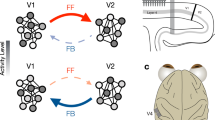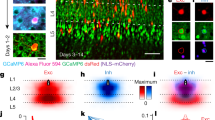Abstract
Neurons in visual cortex are linked by an extensive network of lateral connections. To study the effect of these connections on neural responses, we recorded spikes and local field potentials (LFPs) from multi-electrode arrays that were implanted in monkey and cat primary visual cortex. Spikes at each location generated outward traveling LFP waves. When the visual stimulus was absent or had low contrast, these LFP waves had large amplitudes and traveled over long distances. Their effect was strong: LFP traces at any site could be predicted by the superposition of waves that were evoked by spiking in a ∼1.5-mm radius. As stimulus contrast increased, both the magnitude and the distance traveled by the waves progressively decreased. We conclude that the relative weight of feedforward and lateral inputs in visual cortex is not fixed, but rather depends on stimulus contrast. Lateral connections dominate at low contrast, when spatial integration of signals is perhaps most beneficial.
This is a preview of subscription content, access via your institution
Access options
Subscribe to this journal
Receive 12 print issues and online access
$209.00 per year
only $17.42 per issue
Buy this article
- Purchase on Springer Link
- Instant access to full article PDF
Prices may be subject to local taxes which are calculated during checkout








Similar content being viewed by others
References
Reid, R.C. & Alonso, J.M. Specificity of monosynaptic connections from thalamus to visual cortex. Nature 378, 281–284 (1995).
Priebe, N.J. & Ferster, D. Inhibition, spike threshold and stimulus selectivity in primary visual cortex. Neuron 57, 482–497 (2008).
Ferster, D., Chung, S. & Wheat, H. Orientation selectivity of thalamic input to simple cells of cat visual cortex. Nature 380, 249–252 (1996).
Ferster, D. & Miller, K.D. Neural mechanisms of orientation selectivity in the visual cortex. Annu. Rev. Neurosci. 23, 441–471 (2000).
Chung, S. & Ferster, D. Strength and orientation tuning of the thalamic input to simple cells revealed by electrically evoked cortical suppression. Neuron 20, 1177–1189 (1998).
Ringach, D.L., Hawken, M.J. & Shapley, R. Dynamics of orientation tuning in macaque primary visual cortex. Nature 387, 281–284 (1997).
Sompolinsky, H. & Shapley, R. New perspectives on the mechanisms for orientation selectivity. Curr. Opin. Neurobiol. 7, 514–522 (1997).
Bringuier, V., Chavane, F., Glaeser, L. & Fregnac, Y. Horizontal propagation of visual activity in the synaptic integration field of area 17 neurons. Science 283, 695–699 (1999).
Kenet, T., Bibitchkov, D., Tsodyks, M., Grinvald, A. & Arieli, A. Spontaneously emerging cortical representations of visual attributes. Nature 425, 954–956 (2003).
Tsodyks, M., Kenet, T., Grinvald, A. & Arieli, A. Linking spontaneous activity of single cortical neurons and the underlying functional architecture. Science 286, 1943–1946 (1999).
Allman, J., Miezin, F. & McGuinness, E. Stimulus specific responses from beyond the classical receptive field: neurophysiological mechanisms for local-global comparisons in visual neurons. Annu. Rev. Neurosci. 8, 407–430 (1985).
Levitt, J.B. & Lund, J.S. Contrast dependence of contextual effects in primate visual cortex. Nature 387, 73–76 (1997).
Angelucci, A. et al. Circuits for local and global signal integration in primary visual cortex. J. Neurosci. 22, 8633–8646 (2002).
Jin, J.Z. et al. On and off domains of geniculate afferents in cat primary visual cortex. Nat. Neurosci. 11, 88–94 (2008).
Katzner, S. et al. Local origin of field potentials in visual cortex. Neuron (in the press).
Kitano, M., Niiyama, K., Kasamatsu, T., Sutter, E.E. & Norcia, A.M. Retinotopic and nonretinotopic field potentials in cat visual cortex. Vis. Neurosci. 11, 953–977 (1994).
Benucci, A., Frazor, R.A. & Carandini, M. Standing waves and traveling waves distinguish two circuits in visual cortex. Neuron 55, 103–117 (2007).
Grinvald, A., Lieke, E.E., Frostig, R.D. & Hildesheim, R. Cortical point-spread function and long-range lateral interactions revealed by real-time optical imaging of macaque monkey primary visual cortex. J. Neurosci. 14, 2545–2568 (1994).
Gilbert, C.D. & Wiesel, T.N. Clustered intrinsic connections in cat visual cortex. J. Neurosci. 3, 1116–1133 (1983).
Hirsch, J.A. & Gilbert, C.D. Synaptic physiology of horizontal connections in the cats' visual cortex. J. Neurosci. 11, 1800–1809 (1991).
Bosking, W.H., Zhang, Y., Schofield, B. & Fitzpatrick, D. Orientation selectivity and the arrangement of horizontal connections in tree shrew striate cortex. J. Neurosci. 17, 2112–2127 (1997).
Nowak, L.G., Munk, M.H., James, A.C., Girard, P. & Bullier, J. Cross-correlation study of the temporal interactions between areas V1 and V2 of the macaque monkey. J. Neurophysiol. 81, 1057–1074 (1999).
Song, S., Sjöström, P.J., Reigl, M., Nelson, S. & Chklovskii, D.B. Highly nonrandom features of synaptic connectivity in local cortical circuits. PLoS Biol. 3, e68 (2005).
de la Rocha, J., Doiron, B., Shea-Brown, E., Josic, K. & Reyes, A. Correlation between neural spike trains increases with firing rate. Nature 448, 802–806 (2007).
Dorn, J.D. & Ringach, D.L. Estimating membrane voltage correlations from extracellular spike trains. J. Neurophysiol. 89, 2271–2278 (2003).
Aertsen, A.M. & Gerstein, G.L. Evaluation of neuronal connectivity: sensitivity of cross-correlation. Brain Res. 340, 341–354 (1985).
Hoffman, K.P. & Stone, J. Conduction velocity of afferents to cat visual cortex: a correlation with cortical receptive field properties. Brain Res. 32, 460–466 (1971).
Lampl, I., Reichova, I. & Ferster, D. Synchronous membrane potential fluctuations in neurons of the cat visual cortex. Neuron 22, 361–374 (1999).
Shapley, R., Hawken, M. & Ringach, D.L. Dynamic's of orientation selectivity in the primary visual cortex and the importance of cortical inhibition. Neuron 38, 689–699 (2003).
Sceniak, M.P., Ringach, D.L., Hawken, M.J. & Shapley, R. Contrast's effect on spatial summation by macaque V1 neurons. Nat. Neurosci. 2, 733–739 (1999).
Cavanaugh, J.R., Bair, W. & Movshon, J.A. Nature and interaction of signals from the receptive field center and surround in macaque V1 neurons. J. Neurophysiol. 88, 2530–2546 (2002).
Polat, U., Mizobe, K., Pettet, M.W., Kasamatsu, T. & Norcia, A.M. Collinear stimuli regulate visual responses depending on cell's contrast threshold. Nature 391, 580–584 (1998).
Kohn, A. & Smith, M.A. Stimulus dependence of neuronal correlation in primary visual cortex of the macaque. J. Neurosci. 25, 3661–3673 (2005).
Finn, I.M., Priebe, N.J. & Ferster, D. The emergence of contrast-invariant orientation tuning in simple cells of cat visual cortex. Neuron 54, 137–152 (2007).
Chen, Y., Geisler, W.S. & Seidemann, E. Optimal decoding of correlated neural population responses in the primate visual cortex. Nat. Neurosci. 9, 1412–1420 (2006).
Bernander, O., Douglas, R.J., Martin, K.A. & Koch, C. Synaptic background activity influences spatiotemporal integration in single pyramidal cells. Proc. Natl. Acad. Sci. USA 88, 11569–11573 (1991).
Destexhe, A. & Pare, D. Impact of network activity on the integrative properties of neocortical pyramidal neurons in vivo. J. Neurophysiol. 81, 1531–1547 (1999).
Weliky, M., Kandler, K., Fitzpatrick, D. & Katz, L.C. Patterns of excitation and inhibition evoked by horizontal connections in visual cortex share a common relationship to orientation columns. Neuron 15, 541–552 (1995).
Douglas, R.J. & Martin, K.A. Recurrent neuronal circuits in the neocortex. Curr. Biol. 17, R496–R500 (2007).
Acknowledgements
We are grateful to B. Malone, A. Benucci and S. Katzner for help with data collection and valuable discussions. This work was supported by grants from the US National Institutes of Health (EY-17396 to M.C., EY-12816 and EY-18322 to D.L.R.) and DARPA (FA8650-06-C-7633 to D.L.R.), an Oppenheimer/Stein Endowment Award (D.L.R.), a Scholar Award from the McKnight Endowment Fund for Neuroscience (M.C.) and a Leopoldina fellowship (BMBF-LPD9901/8-165 to L.B.). M.C. holds the GlaxoSmithKline/Fight for Sight Chair in Visual Neuroscience.
Author information
Authors and Affiliations
Contributions
All authors contributed in the execution of the experiments, the analysis of the data and the writing of the manuscript.
Corresponding author
Supplementary information
Supplementary Text and Figures
Supplementary Figures 1 and 2 (PDF 865 kb)
Rights and permissions
About this article
Cite this article
Nauhaus, I., Busse, L., Carandini, M. et al. Stimulus contrast modulates functional connectivity in visual cortex. Nat Neurosci 12, 70–76 (2009). https://doi.org/10.1038/nn.2232
Received:
Accepted:
Published:
Issue Date:
DOI: https://doi.org/10.1038/nn.2232
This article is cited by
-
Machine learning-based high-frequency neuronal spike reconstruction from low-frequency and low-sampling-rate recordings
Nature Communications (2024)
-
Beta traveling waves in monkey frontal and parietal areas encode recent reward history
Nature Communications (2023)
-
Waves traveling over a map of visual space can ignite short-term predictions of sensory input
Nature Communications (2023)
-
Visual evoked feedforward–feedback traveling waves organize neural activity across the cortical hierarchy in mice
Nature Communications (2022)
-
Frequency modulation of cortical rhythmicity governs behavioral variability, excitability and synchrony of neurons in the visual cortex
Scientific Reports (2022)



